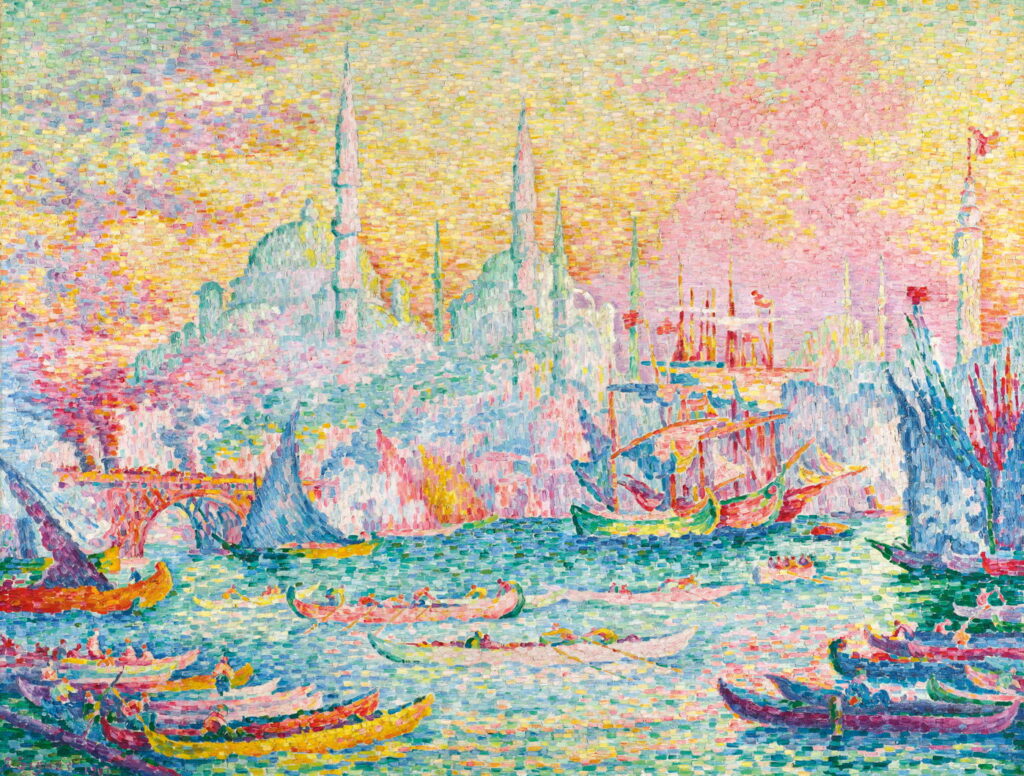A painted visit to Istanbul and Turkey 2

In the first of these two collections of paintings of the city of Istanbul and its surroundings, I looked a little at its history, then views painted by European visitors during the nineteenth century, reaching the work of the Italian artist Alberto Pasini and his signature green melons.
Alberto Pasini (1826–1899), By the Fountain, Constantinople (1882), oil on canvas, 46 x 38.5 cm, Private collection. The Athenaeum.
In 1882, Pasini painted this view By the Fountain, Constantinople combining a small market, with its melon seller of course, and three horses sheltering as well as they can from the blazing midday sun.
Alberto Pasini (1826–1899), A Market Scene (1884), further details not known. Wikimedia Commons.
Seven years later, Pasini painted A Market Scene showing an eclectic mixture of produce, ranging from live chickens to pots and the ever-present melons. To the left of centre is a ramshackle horse-drawn carriage.
Alberto Pasini (1826–1899), A Mosque (1886), oil on canvas, 37.1 x 55.2 cm, Metropolitan Museum of Art, New York, NY. Wikimedia Commons.
A Mosque (1886) is the second of Pasini’s two paintings in the Met, and a marked contrast from the earlier one. There are no smart carriages here, and most of the exterior of the building is in need of decoration if not repair. But there’s a small market running, and you can still get melons too, as shown in the detail below.
Alberto Pasini (1826–1899), A Mosque (detail) (1886), oil on canvas, 37.1 x 55.2 cm, Metropolitan Museum of Art, New York, NY. Wikimedia Commons.
The great Swedish artist Anders Zorn visited Turkey in 1886.
Anders Zorn (1860–1920), Bedouin Girl (1886), watercolour on paper, 30.5 x 22 cm, Private collection. Wikimedia Commons.
One portrait he completed before leaving the country is this Bedouin Girl (1886) he saw in Constantinople.
Although little-known outside Turkey, one of its pioneering artists was Osman Hamdi Bey, a senior administrator in the late years of the Ottoman Empire, and its first modern archaeologist. The son of a Grand Vizier, he travelled to Paris in 1860 to study law but changed to become a pupil of Jean-Léon Gérôme and Gustave Boulanger.
Osman Hamdi Bey (1842–1910), Persian Carpet Dealer on the Street (1888), oil, dimensions not known, Alte Nationalgalerie, Berlin. Wikimedia Commons.
The wonderful assortment of characters in Osman Hamdi’s panoramic view of a Persian Carpet Dealer on the Street (1888) reflects the cosmopolitan population of Istanbul, sitting at the gateway between Europe and Asia Minor.
Osman Hamdi Bey (1842–1910), Arzuhalci (Public Scribe) (1910), oil, 77 x 110 cm, Sakıp Sabancı Museum, Istanbul, Turkey. Wikimedia Commons.
Another familiar street scene of the day, Osman Hamdi’s Public Scribe (1910) may have been part of a campaign to improve education and literacy, particularly among women.
Osman Hamdi Bey (1842–1910), The Tortoise Trainer (1906), oil on canvas, 221.5 x 120 cm, Pera Müzesi, Istanbul. Wikimedia Commons.
Osman Hamdi’s magnificent Tortoise Trainer from 1906 is by far his best-known painting, and set the record for the highest price paid for a Turkish painting when it was sold in 2004 for $3.5 million.
Its ingenious allegory can be read in at least two ways. The artist may have been self-critical of his painstakingly slow work; tortoises are not only inherently slow, but in the early eighteenth century had been used in Istanbul to bear lit candles for evening outings. This painting also had a greater political meaning, as the tortoise trainer wears traditional Ottoman religious costume from before the middle of the nineteenth century, and is training the tortoises with a traditional Turkish ney flute.
In that sense, it’s a satire on the slow, faltering, and often ineffective reforms made to the Ottoman Empire during the late nineteenth century, an issue with which Osman Hamdi had much personal experience. This resulted in a time of increasing social and political upheaval, preceding the Young Turk Revolution of 1908 which changed the basis of rule in the empire, followed by the breakup of the empire after the First World War.
Michael Zeno Diemer (1867–1939), The Ahırkapı Lighthouse (1906-07), oil on canvas, 82.5 × 100 cm, Pera Müzesi, Istanbul, Turkey. Wikimedia Commons.
Michael Zeno Diemer’s brilliant painting of The Ahırkapı Lighthouse (1906-07) shows one of the oldest tower lighthouses at one of the most notable coastal landmarks: the southern entrance to the Straits of Bosporus, to the south of Istanbul. This lighthouse is on the European side; its opposite number is the Kadıköy İnciburnu lighthouse to the east, which would be off the right edge of this painting.
Paul Signac (1863-1935), La Corne d’Or (The Golden Horn) (Cachin 464) (1907), oil on canvas, 89.2 x 116.3 cm, Private collection. Wikimedia Commons.
In late March 1907 Paul Signac travelled with the painter Henri Person (1876-1926) to Constantinople, where they painted for six weeks before returning to France. This is the only accessible finished painting from Signac’s visit to what’s known in French as La Corne d’Or, or The Golden Horn, (1907). Using the same compositional technique that had proved so successful in his views of Venice, this shows the Süleymaniye Mosque on the Third Hill from the north-west, on the western (European) side of the Bosporus Strait.
In the foreground are brightly coloured rowing boats taking part in what looks like a regatta, and a row of sailing ships on moorings, all in the waters of the Golden Horn. The mosque is relatively desaturated as it dissolves into the distant pink and gold sky. This mosque was built between 1550-57 for Suleiman the Magnificent, and encloses the mausoleums of the Sultan of the Ottoman Empire and his wife. It’s one of the best-known sights in the city of Istanbul, and an ideal view for Signac’s treatment.
At that point, bathed in Signac’s colour and light, I’m afraid it’s time to cross the Bosporus and return to Europe.



